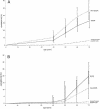Variation in cancer risks, by mutation position, in BRCA2 mutation carriers
- PMID: 11170890
- PMCID: PMC1235274
- DOI: 10.1086/318181
Variation in cancer risks, by mutation position, in BRCA2 mutation carriers
Abstract
Cancer occurrence in 164 families with breast/ovarian cancer and germline BRCA2 mutations was studied to evaluate the evidence for genotype-phenotype correlations. Mutations in a central portion of the gene (the "ovarian cancer cluster region" [OCCR]) were associated with a significantly higher ratio of cases of ovarian:breast cancer in female carriers than were mutations 5' or 3' of this region (P<.0001), extending previous observations. The optimal definition of the OCCR, as judged on the basis of deviance statistics, was bounded by nucleotides 3059-4075 and 6503-6629. The relative and absolute risks of breast and ovarian cancer associated with OCCR and non-OCCR mutations were estimated by a conditional likelihood approach, conditioning on the set of mutations observed in the families. OCCR mutations were associated both with a highly significantly lower risk of breast cancer (relative risk [RR] 0.63; 95% confidence interval (95% CI) 0.46-0.84; P=.0012) and with a significantly higher risk of ovarian cancer (RR = 1.88; 95% CI = 1.08-3.33; P=.026). No other differences in breast or ovarian cancer risk, by mutation position, were apparent. There was some evidence for a lower risk of prostate cancer in carriers of an OCCR mutation (RR = 0.52; 95% CI = 0.24-1.00; P=.05), but there was no evidence of a difference in breast cancer risk in males. By age 80 years, the cumulative risk of breast cancer in male carriers of a BRCA2 mutation was estimated as 6.92% (95% CI = 1.20%-38.57%). Possible mechanisms for the variation in cancer risk are suggested by the coincidence of the OCCR with the RAD51-binding domain.
Figures
References
Electronic-Database Information
-
- Online Mendelian Inheritance in Man (OMIN), http://www.ncbi.nlm.nih.gov/Omim (for inherited breast cancer type 2 [MIM 600185])
References
-
- Aihara H, Ito Y, Kurumizaka H, Yokoyama S, Shibata T (1999) The N-terminal domain of the human Rad51 binding surface as revealed by NMR. J Mol Biol 290:495–504 - PubMed
-
- Bertwistle D, Swift S, Marston NJ, Jackson LE, Crossland S, Crompton MR, Marshall CJ, Ashworth A (1997) Nuclear location and cell cycle regulation of the BRCA2 protein. Cancer Res 57:5485–5488 - PubMed
-
- Bièche I, Lidereau R (1999) Increased level of exon 12 alternatively spliced BRCA2 transcripts in tumour breast tissue compared with normal tissue. Cancer Res 59:2546–2550 - PubMed
-
- Bork P, Blomberg N, Niges M (1996) Internal repeats in the BRCA2 protein sequence. Nat Genet 13:22–23 - PubMed
-
- Breast Cancer Linkage Consortium (1999) Cancer risks in BRCA2 mutation carriers. J Natl Cancer Inst 91:1310–1316 - PubMed
Publication types
MeSH terms
Substances
Associated data
- Actions
Grants and funding
LinkOut - more resources
Full Text Sources
Research Materials
Miscellaneous



